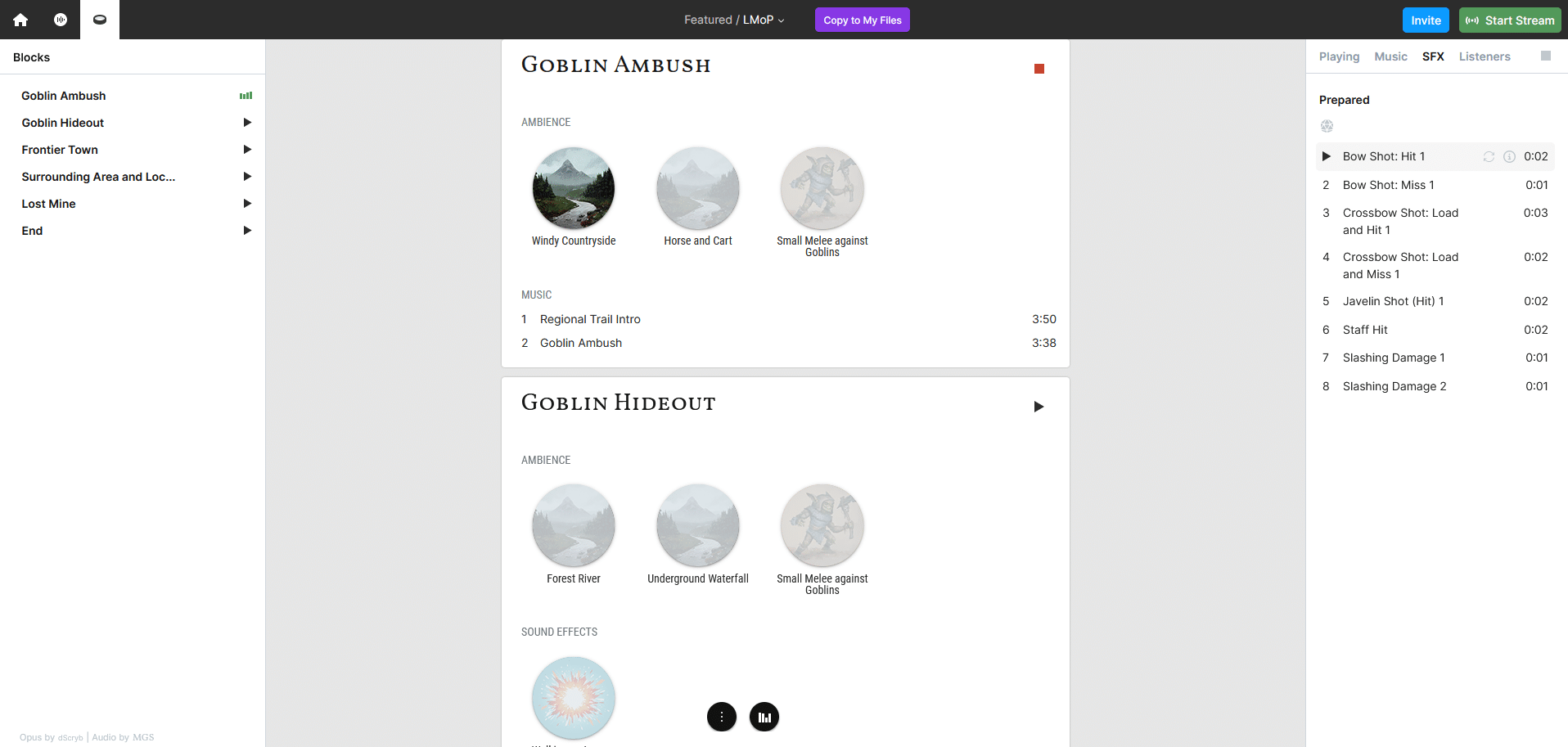Product Spotlight: Make Your Worlds Come to Life With dScryb’s Opus
Published on January 11, 2024, Last modified on April 18th, 2024
dScryb’s new soundscape-crafting tool can create an unparalleled TTRPG experience by combining gorgeous sounds with impeccably crafted boxed text, all accessible through an user-friendly interface.

Table of Contents
This post was sponsored by dScryb. As always, all opinions are entirely our own.
What is dScryb?
dScryb is an ENNIE award-winning platform that has been a beacon of creativity for tabletop roleplaying gamers for years now. As part of their service, they provide purpose-crafted short descriptions of places, creatures, and objects, which increase immersion and enhance the storytelling aspect of RPGs, all while taking work off the DM’s plate.
They introduced the Sonic Library a year ago, which melds their boxed text with beautifully crafted music and ambiences to help set the scene. Now, Opus is the next step in their journey to enrich the narrative experience for players and DMs.
My Experience Using Opus
This cutting-edge software combines dScryb’s boxed text with its library of over 3,000 sounds from which you can build scenes and organize them into an easy-to-use view for adventure environments or whole campaigns. If this sounds interesting to you, you can try it out for yourself with a 14-day free trial!
To test it out, I ran the first couple chapters of the official 5e adventure, Phandelver and Below: The Shattered Obelisk (which is essentially just Lost Mine of Phandelver), and here’s how it went:
The Set Up
I chose to take Opus for a spin using this adventure because the first thing I saw when I opened up Opus’ homepage was the LMoP collection:
This collection has “blocks” set up for every adventure environment in the campaign, from the goblin ambush, to Phandalin, to Wave Echo Cave.
Each block contains a mixture of sound effects, music, and boxed text that can be read aloud to set the scene. Navigating between the blocks is simple, and the UI is perfectly intuitive. You can also control the volume of the ambiance, music, and sound effects with a volume mixer to get the perfect balance.
One of the best parts of the software is you can invite your players to join so they can stream the music through their own browser. They don’t need a subscription or to download any software, you don’t have to rig up your voice/video chat to also project the sounds. They just click the link, and can hear what you’re hearing
Better yet, players can keep the browser tab minimized while you control the sounds on your end, and they update in real-time. It’s like magic!
All in all, setting up the scenes for my sessions and figuring out how to work the software took maybe 5 minutes, and the sounds were super easy to manipulate on the fly during the session.
The Sounds
As can be expected, the audio from Michael Ghelfi Studios is top-notch. The library contains a truly extraordinary amount of choices, from sound effects to ambiences and (my favorite) repeatable music. There’s something for every adventure, whether you’re playing in a fantasy, sci-fi, or real-world setting.
For those who want a taste of MGS’ work, I can’t recommend their YouTube channel enough. They’ve got awesome mixes to use in your games or, if you’re like me, to listen to in the background while you write your campaigns.
Bringing Boxed Text to Life
The true power of Opus lies in its ability to blend dScryb’s detailed narrative elements with a rich audio landscape. I’ve used their boxed text in conjunction with their Sonic Library for adventures before, but the ambient soundscapes you can build with Opus take everything to another level.
Plus, they’re honestly really easy to set up. Here’s a tavern scene I set up in about 30 seconds, complete with boxed text, ambiance, sound effects, and music:
The Verdict
What I am most impressed with when using Opus is that it takes the adventure environment out of a player’s imagination and allows it to actually resonate in your player’s ears, which creates immersion like nothing else.
Opus transformed the experience for the sessions I ran in Phandelver and Below. The auditory elements, from the creak of the wagon’s wheels to the first arrow fired by a goblin, brought a sense of realism and urgency to the gameplay.
As a forever DM, I’ve used numerous tools to organize my thoughts, build my worlds, and run my sessions. However, Opus stands out from the crowd. It’s not just its user-friendly interface or its powerful library of boxed text and sounds; it’s the way Opus brings a whole new dimension to gameplay.
Being a game that primarily takes place in the DM’s and player’s imagination, D&D can greatly benefit by adding concrete sensory experiences to latch onto. You can use maps or miniatures for visuals and props for touch, but incorporating sound can really amplify the immersion.
Start Your Free Trial Today
We’ll leave this review with some exciting news for all you Dungeon Masters and world builders out there: dScryb offers a 14-day free trial, giving you a chance to experience the magic of Opus firsthand. Seeing as all of their tiers get the same access to the trial, I recommend going for their Celestial subscription so you can take all of their functionality for a spin.
If you’ve got some sessions coming up that you want to add a whole other level of immersion to, I highly recommend checking out the boxed text and soundscapes you can build quickly and easily with this stellar tool.



